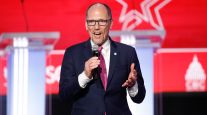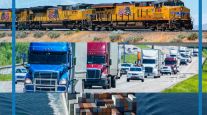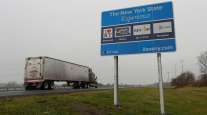Obama Seeks Road Funds
This story appears in the April 15 print edition of Transport Topics.
President Obama’s 2014 budget contains a one-time boost of $27 billion for “critical highway infrastructure” and cross-border roads to augment the $41 billion Congress has already authorized for highways next year.
The president also said in his budget released April 10 that he wants Congress to increase the nation’s annual spending commitment to highways and public transit by 25% in 2015.
That’s the year by which Congress must pass a new transportation funding bill to replace the current spending law, MAP-21, which only authorized funding for fiscal 2013 and 2014.
The budget “makes an immediate investment to put people to work as soon as possible on our most urgent repairs, like the nearly 70,000 structurally deficient bridges across the country,” the president said.
The $27 billion for highways and bridges is part of a larger $50 billion transportation infrastructure investment plan Obama proposed for roads, transit, railroads and airports. He has tried before to persuade Congress to approve such an investment to spur job creation.
The new spending, both the short-term infusion and the 25% increase in 2015, would be paid for by winding down the wars in Iraq and Afghanistan, the president said.
The budget calls for $76.6 billion in funding for the Department of Transportation next year, a 5.5% increase compared with 2012.
Highway and other transportation advocates criticized the president’s budget plan for not including long-range funding solutions for transportation.
Bud Wright, executive director of the American Association of State Highway and Transportation Officials, was among the skeptics. While AASHTO members support Obama’s efforts to increase transportation funding, they “remain convinced the principal challenge will be to identify a long-term, sustainable revenue source for transportation investments,” Wright said.
American Trucking Associations President Bill Graves said: “For five years, we’ve waited for President Obama to clearly state how we should pay for these critical needs and, I’m sad to say, we continue to get lip service about the importance of roads and bridges with no real road map to real funding solutions.”
Added ATA Chairman Michael Card, president of Combined Transport, Central Point, Ore., “A safe and efficient network of highways is critical, not just to my business but to all businesses in this country.”
ATA, the U.S. Chamber of Commerce, road builders and others have called on the president to support higher fuel taxes to pay for transportation.
The Highway Trust Fund, which pays for construction and maintenance, is expected to be insolvent in 2015 as increasingly fuel-efficient cars and trucks narrow the revenue stream generated by diesel and gasoline taxes.
The budget compares 2014 spending with 2012 spending, rather than 2013, because of sequestration — the automatic budget cuts that started this year when Congress and the White House could not agree on deficit reduction. The rolling budget reductions are cutting what was authorized for government agencies in 2013.
The Federal Motor Carrier Safety Administration would see its budget increase to $572 million in 2014, compared with the $554.7 million spent in 2012. For 2014, there would be 1,088 full-time employees, up from 1,049 in 2012.
U.S. Deputy Secretary of Transportation John Porcari said the additional employees will be truck and bus safety inspectors assigned out in the field.
The Pipeline and Hazardous Materials Safety Administration budget would be $255.3 million, compared with $191.1 million in 2012. The increase is to support the increased safety regulations contained in MAP-21 and other new pipeline safety laws, the president’s budget said.
The transportation community is frustrated by Obama’s latest budget because it “got it” when the president, newly elected and facing a crippling recession, declined to raise fuel taxes, said Joshua Schank, president of the Eno Center for Transportation, a Washington think tank.
“But there was a hope, or at least an illusion, that perhaps in a second term — with budget negotiations on the table, with taxes clearly on the table — that one of those revenue sources might be directed towards transportation,” Schank said.
Long-term funding sources, not one-shot, $50 billion infusions, are needed, Schank said.
“The president’s budget repeats his call to increase spending without identifying a viable means to pay for it,” said House Transportation and Infrastructure Committee Chairman Bill Shuster (R-Pa.).
“The president indicates he wants to use savings from reduced overseas military operations to pay for infrastructure improvements, but this is not a long-term solution and only further emphasizes that we’re spending more than we’re taking in,” said Rep. Tom Petri (R-Wis.), chairman of the House Subcommittee on Highways and Transit.
The president deserves credit for his continued support for infrastructure investment, but his funding assertions may not be tangible, said Brian Deery, director of highways and transportation for the Associated General Contractors.
“The only offset I see is the savings from not spending money on Iraq, but that was already off budget anyway, so it’s not a savings within the budget,” Deery said.




